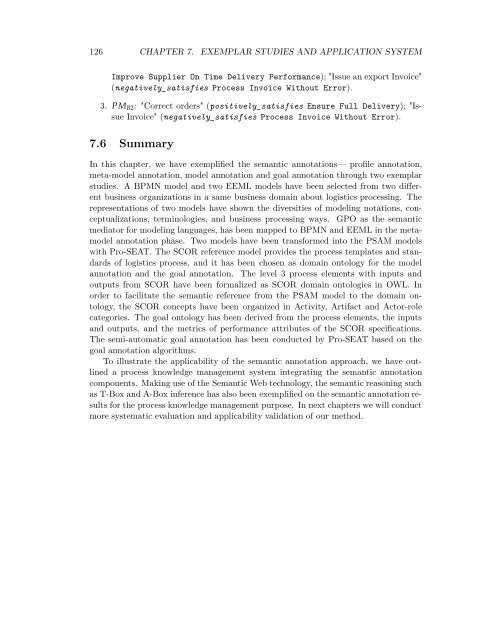Semantic Annotation for Process Models: - Department of Computer ...
Semantic Annotation for Process Models: - Department of Computer ...
Semantic Annotation for Process Models: - Department of Computer ...
Create successful ePaper yourself
Turn your PDF publications into a flip-book with our unique Google optimized e-Paper software.
126 CHAPTER 7. EXEMPLAR STUDIES AND APPLICATION SYSTEM<br />
Improve Supplier On Time Delivery Per<strong>for</strong>mance); "Issue an export Invoice"<br />
(negatively_satisfies <strong>Process</strong> Invoice Without Error).<br />
3. PM B2 : "Correct orders" (positively_satisfies Ensure Full Delivery); "Issue<br />
Invoice" (negatively_satisfies <strong>Process</strong> Invoice Without Error).<br />
7.6 Summary<br />
In this chapter, we have exemplified the semantic annotations— pr<strong>of</strong>ile annotation,<br />
meta-model annotation, model annotation and goal annotation through two exemplar<br />
studies. A BPMN model and two EEML models have been selected from two different<br />
business organizations in a same business domain about logistics processing. The<br />
representations <strong>of</strong> two models have shown the diversities <strong>of</strong> modeling notations, conceptualizations,<br />
terminologies, and business processing ways. GPO as the semantic<br />
mediator <strong>for</strong> modeling languages, has been mapped to BPMN and EEML in the metamodel<br />
annotation phase. Two models have been trans<strong>for</strong>med into the PSAM models<br />
with Pro-SEAT. The SCOR reference model provides the process templates and standards<br />
<strong>of</strong> logistics process, and it has been chosen as domain ontology <strong>for</strong> the model<br />
annotation and the goal annotation. The level 3 process elements with inputs and<br />
outputs from SCOR have been <strong>for</strong>malized as SCOR domain ontologies in OWL. In<br />
order to facilitate the semantic reference from the PSAM model to the domain ontology,<br />
the SCOR concepts have been organized in Activity, Artifact and Actor-role<br />
categories. The goal ontology has been derived from the process elements, the inputs<br />
and outputs, and the metrics <strong>of</strong> per<strong>for</strong>mance attributes <strong>of</strong> the SCOR specifications.<br />
The semi-automatic goal annotation has been conducted by Pro-SEAT based on the<br />
goal annotation algorithms.<br />
To illustrate the applicability <strong>of</strong> the semantic annotation approach, we have outlined<br />
a process knowledge management system integrating the semantic annotation<br />
components. Making use <strong>of</strong> the <strong>Semantic</strong> Web technology, the semantic reasoning such<br />
as T-Box and A-Box inference has also been exemplified on the semantic annotation results<br />
<strong>for</strong> the process knowledge management purpose. In next chapters we will conduct<br />
more systematic evaluation and applicability validation <strong>of</strong> our method.
















